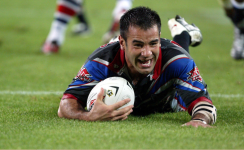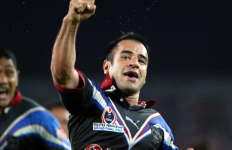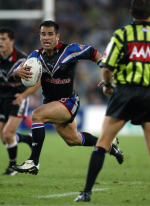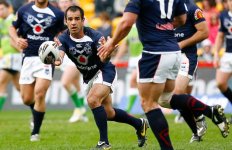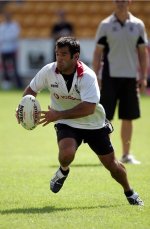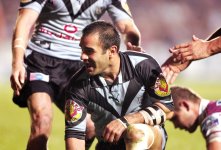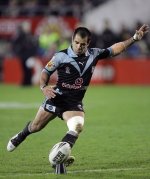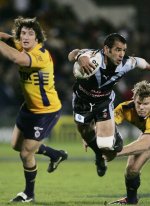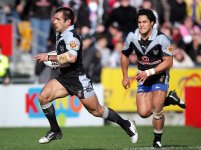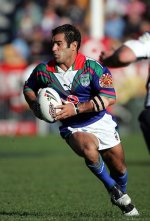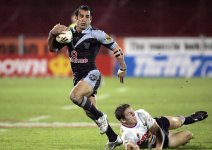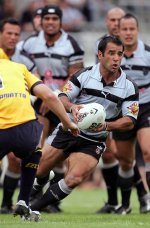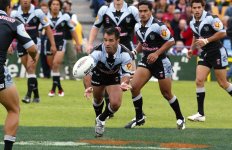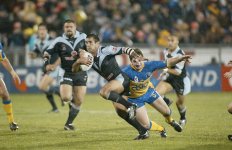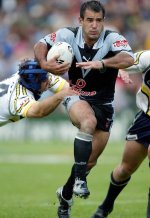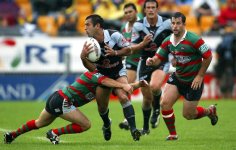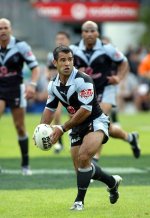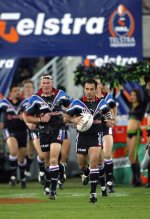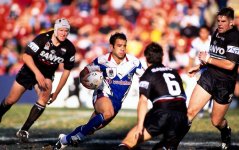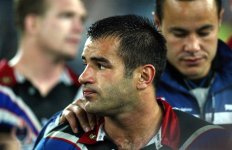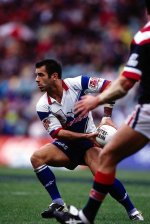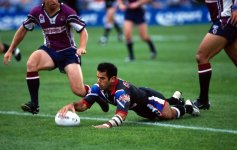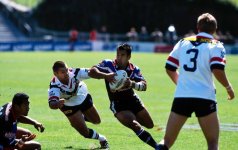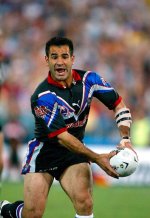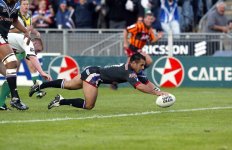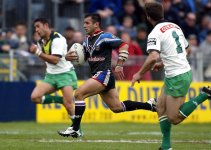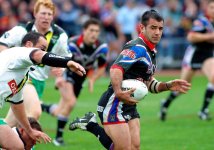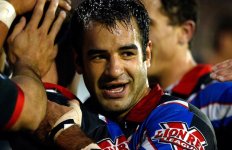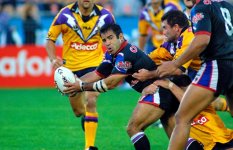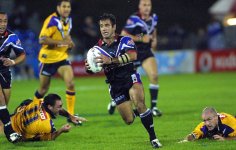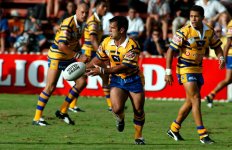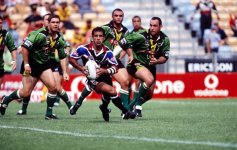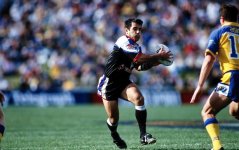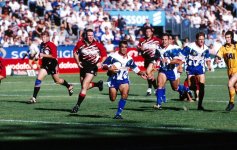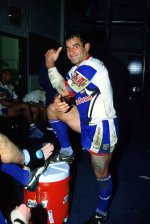mt.wellington
Contributor
Stacey William Jones ONZM (born 7 May 1976) is a New Zealand former professional rugby league footballer, who has been named amongst the greatest New Zealand has ever produced. He played as a halfback, but he has also briefly played at five-eighth during his distinguished career, which includes 46 Tests for New Zealand (1995–2006). Stacey Jones is the first and only life member of the New Zealand Warriors club whose records for most appearances, tries and points he held at the time of his retirement.
Jones' vision and ability to control the game when his team was on attack earned him the sobriquet "the little general", a reference also to his small stature in comparison to that of most rugby league players. Jones was often able to find players with a high bombing kick at either sides of the field or place a sneaky through ball for oncoming players to pounce on.
Of Māori descent, Stacey Jones was born in Auckland, New Zealand on 7 May 1976, a grandchild to New Zealand rugby league great Maunga Emery. He played junior grades for the Ponsonby Ponies and Mt Albert Lions before moving to the suburb-Pt Chev Pirates when he was 9. Jones attended St. Paul's College, Auckland. In 1994 he played for the Auckland City Vulcans side in the Lion Red Cup. In July 1994 he captained the Junior Kiwis as they toured Australia. Here he played against Darren Lockyer, who was playing for the Junior Kangaroos at the time.
Jones was spotted by the new Auckland Warriors franchise and made his first grade debut in 1995 against the Parramatta Eels in their inaugural year in what is now the National Rugby League (NRL).
On 23 April 1995 Jones made his first-grade début in Sydney, coming off bench to score a try in the Warriors' 40–4 win over the Parramatta Eels. The Warriors' halfback Greg Alexander missed Rounds 10 and 11 through injury which resulted in Jones taking over at halfback. Jones played well enough to retain the position and force Alexander to move to fullback upon his return. He also quickly established his place in the international scene, replacing Gary Freeman as the New Zealand national rugby league team halfback during the 1995 World Cup.
Over the next several years Jones cemented his spot in both the Warriors and Kiwis, sticking with the Warriors despite the lack of success on and off the field. Between 1995 and 1999 he played over 100 consecutive first grade games for the Warriors. In 1999 he broke his arm playing for the Kiwis against Tonga, and as a result missed the first half of the 2000 NRL season, breaking his consecutive streak. At the end of 2000 the Warriors were bankrupt and were sold for the second time in their short history. Jones was the first signing by the new franchise, with owner Eric Watson, and it was his signing that convinced many other players to re-sign with the club.
It was under the new management where he first became club captain – in 2001 co-captaining with Kevin Campion – and although already considered in the top reaches of halfbacks in the NRL, he started to show he was on an equal par with the games' best halfbacks at the time. In the 3-year period 2001-03 he led the Warriors to 3 successive finals appearances. In 2002 the club not only won the Minor Premiership, but also reached the 2002 NRL grand final against the Sydney Roosters. Playing at scrum half back, Jones captained the losing side that evening but scored a great try in which he beat 3 Roosters defenders from 30 metres out to go over from dummy half. He was then selected to go on the 2002 New Zealand rugby league tour of Great Britain and France and won the George Smith Medal as player of the series against Great Britain. Also in 2002, Jones became only the second New Zealand player to win the Golden Boot Award for the best international rugby league player.
In his career, he has also represented New Zealand at two World Cups (1995 and 2000), three Tri Nations series (1999, 2005, 2006), and has played 41 games for the New Zealand Kiwis. He retired from the national team in 2004 while having a disappointing year at club level. However, on 15 October 2005 Stacey ended 2 years of international retirement, answering an SOS from Kiwis coach Brian McClennan intending only to play the Australasian section of the Tri Nations series. He then went on to play the rest of their round robin matches against Great Britain in England. Stacey Jones was an integral part of the New Zealand Tri Nations campaign. In the first match, he guided the Kiwis to their first win in Sydney in 50 years before being part of their narrow loss to Australia in Auckland. He set up 4 tries in the first match in England which the Kiwis won by 42–26. He then missed the fourth Kiwi game, instead returning to New Zealand to be with his wife for the birth of their son. In the 2005 Rugby League Tri-Nations Final, he continually kicked Bombs aimed at the Australian wingers that set up three tries in the Kiwis' 24–0 victory over Australia. Until then Australia had not lost a series in 27 years.
Jones is widely regarded as the best New Zealand player of his generation. In New Zealand he had a video game named after him, Stacey Jones' Rugby League. He currently still holds the record for most appearances (238 NRL games) and is the second highest try scorer (77) behind Manu Vatuvei (99).
In April 2005 Stacey Jones announced he was leaving the Warriors, then his only professional club to join the new French addition to the Super League for the 2006 season Catalans Dragons. In doing so he became the last foundation member of the Warriors to leave the club.
After the 2006 Rugby League Tri-Nations Final it was announced that Jones was retiring from international football however he returned for a final time against a 'Northern Union' side for New Zealand 'All Golds' to celebrate the centenary of New Zealand's national rugby league team who first toured England in 1907. Jones kicked five goals as the 'All Golds' won 25–18 at Warrington's Halliwell Jones stadium.
Jones helped Catalans reach the 2007 Challenge Cup Final. In September 2007 he announced his retirement from the game and left the Dragons.
Stacey Jones returned home and rejoined the New Zealand Warriors as their kicking coach for the 2008 season. As part of his release from the Dragons he was not allowed to play for any other club during the 2008 season.
During the New Zealand 2008 election Jones publicly appeared with then Prime Minister Helen Clark and offered his support to the Labour Party campaign.
In November 2008 he played for the All Golds again in New Plymouth against the New Zealand Māori. The game served as both a testimonial to Ruben Wiki and a warm up for the 2008 World Cup. Participating in this game made Jones realise he still wanted to play rugby league.
On 7 November 2008 it was announced that Stacey Jones had re-signed as a player with the New Zealand Warriors on a one-year contract for 2009. He reportedly signed a contract worth over $220,000.
In his March 2009 return game to the NRL, Jones set up two tries and guided his team to a 26–24 victory over Manly, reaffirming his nickname as "The Little General". Despite being predicted to play mostly off the bench in 2009, the early release of incumbent halfback Nathan Fien in June saw Jones thrust into the familiar role of starting playmaker for the Warriors once again. Unfortunately, Jones' early good form did not continue and the Warriors struggled to a disappointing 14th placing on the ladder.
In early September Jones announced that his comeback was over and he would not be returning for the 2010 NRL season.

 en.wikipedia.org
en.wikipedia.org
Former Junior Kiwi Test captain made his mark as a 19-year-old halfback in the Warriors’ debut season. The grandson of Maunga Emery, NZ international halfback of the 1960s, Jones was selected in the Kiwis’ World Cup squad at the end of 1995 and was a regular visitor to the Test arena during the next decade. In 1999 he became the first Auckland player to pass 100 first grade games but missed NZ’s Tri-series campaign when he broke his wrist in a warm-up match against Tonga. A member of the 2000 World Cup team that was beaten in the final by Australia, Jones’ great form was a highlight in the Warriors’ 2001-02 seasons in which the club first made the final eight and then qualified for the grand final against the Roosters. Jones won the ‘Golden Boot’ award for international player of the year in 2002 but after 34 Tests his club form wavered and he suddenly seemed to be out of favour with Warriors and NZ national coach Daniel Anderson. The record holder for most games for the Warriors, and the leading point-scorer and try-scorer in his decade with the club, Jones announced that he would be joining French Super League club Les Catalans in 2006. He finished the year be starring in NZ’s stunning 24-0 victory over Australia in the final of the 2005 Tri-Nations competition. A year later he again rejoined the Kiwi Test team but announced his international retirement following NZ’s 16-12 loss in extra-time against Australia in the final of the Tri-Nations competition in November.
- ALAN WHITICKER
 www.rugbyleagueproject.org
www.rugbyleagueproject.org
Jones' vision and ability to control the game when his team was on attack earned him the sobriquet "the little general", a reference also to his small stature in comparison to that of most rugby league players. Jones was often able to find players with a high bombing kick at either sides of the field or place a sneaky through ball for oncoming players to pounce on.
Of Māori descent, Stacey Jones was born in Auckland, New Zealand on 7 May 1976, a grandchild to New Zealand rugby league great Maunga Emery. He played junior grades for the Ponsonby Ponies and Mt Albert Lions before moving to the suburb-Pt Chev Pirates when he was 9. Jones attended St. Paul's College, Auckland. In 1994 he played for the Auckland City Vulcans side in the Lion Red Cup. In July 1994 he captained the Junior Kiwis as they toured Australia. Here he played against Darren Lockyer, who was playing for the Junior Kangaroos at the time.
Jones was spotted by the new Auckland Warriors franchise and made his first grade debut in 1995 against the Parramatta Eels in their inaugural year in what is now the National Rugby League (NRL).
On 23 April 1995 Jones made his first-grade début in Sydney, coming off bench to score a try in the Warriors' 40–4 win over the Parramatta Eels. The Warriors' halfback Greg Alexander missed Rounds 10 and 11 through injury which resulted in Jones taking over at halfback. Jones played well enough to retain the position and force Alexander to move to fullback upon his return. He also quickly established his place in the international scene, replacing Gary Freeman as the New Zealand national rugby league team halfback during the 1995 World Cup.
Over the next several years Jones cemented his spot in both the Warriors and Kiwis, sticking with the Warriors despite the lack of success on and off the field. Between 1995 and 1999 he played over 100 consecutive first grade games for the Warriors. In 1999 he broke his arm playing for the Kiwis against Tonga, and as a result missed the first half of the 2000 NRL season, breaking his consecutive streak. At the end of 2000 the Warriors were bankrupt and were sold for the second time in their short history. Jones was the first signing by the new franchise, with owner Eric Watson, and it was his signing that convinced many other players to re-sign with the club.
It was under the new management where he first became club captain – in 2001 co-captaining with Kevin Campion – and although already considered in the top reaches of halfbacks in the NRL, he started to show he was on an equal par with the games' best halfbacks at the time. In the 3-year period 2001-03 he led the Warriors to 3 successive finals appearances. In 2002 the club not only won the Minor Premiership, but also reached the 2002 NRL grand final against the Sydney Roosters. Playing at scrum half back, Jones captained the losing side that evening but scored a great try in which he beat 3 Roosters defenders from 30 metres out to go over from dummy half. He was then selected to go on the 2002 New Zealand rugby league tour of Great Britain and France and won the George Smith Medal as player of the series against Great Britain. Also in 2002, Jones became only the second New Zealand player to win the Golden Boot Award for the best international rugby league player.
In his career, he has also represented New Zealand at two World Cups (1995 and 2000), three Tri Nations series (1999, 2005, 2006), and has played 41 games for the New Zealand Kiwis. He retired from the national team in 2004 while having a disappointing year at club level. However, on 15 October 2005 Stacey ended 2 years of international retirement, answering an SOS from Kiwis coach Brian McClennan intending only to play the Australasian section of the Tri Nations series. He then went on to play the rest of their round robin matches against Great Britain in England. Stacey Jones was an integral part of the New Zealand Tri Nations campaign. In the first match, he guided the Kiwis to their first win in Sydney in 50 years before being part of their narrow loss to Australia in Auckland. He set up 4 tries in the first match in England which the Kiwis won by 42–26. He then missed the fourth Kiwi game, instead returning to New Zealand to be with his wife for the birth of their son. In the 2005 Rugby League Tri-Nations Final, he continually kicked Bombs aimed at the Australian wingers that set up three tries in the Kiwis' 24–0 victory over Australia. Until then Australia had not lost a series in 27 years.
Jones is widely regarded as the best New Zealand player of his generation. In New Zealand he had a video game named after him, Stacey Jones' Rugby League. He currently still holds the record for most appearances (238 NRL games) and is the second highest try scorer (77) behind Manu Vatuvei (99).
In April 2005 Stacey Jones announced he was leaving the Warriors, then his only professional club to join the new French addition to the Super League for the 2006 season Catalans Dragons. In doing so he became the last foundation member of the Warriors to leave the club.
After the 2006 Rugby League Tri-Nations Final it was announced that Jones was retiring from international football however he returned for a final time against a 'Northern Union' side for New Zealand 'All Golds' to celebrate the centenary of New Zealand's national rugby league team who first toured England in 1907. Jones kicked five goals as the 'All Golds' won 25–18 at Warrington's Halliwell Jones stadium.
Jones helped Catalans reach the 2007 Challenge Cup Final. In September 2007 he announced his retirement from the game and left the Dragons.
Stacey Jones returned home and rejoined the New Zealand Warriors as their kicking coach for the 2008 season. As part of his release from the Dragons he was not allowed to play for any other club during the 2008 season.
During the New Zealand 2008 election Jones publicly appeared with then Prime Minister Helen Clark and offered his support to the Labour Party campaign.
In November 2008 he played for the All Golds again in New Plymouth against the New Zealand Māori. The game served as both a testimonial to Ruben Wiki and a warm up for the 2008 World Cup. Participating in this game made Jones realise he still wanted to play rugby league.
On 7 November 2008 it was announced that Stacey Jones had re-signed as a player with the New Zealand Warriors on a one-year contract for 2009. He reportedly signed a contract worth over $220,000.
In his March 2009 return game to the NRL, Jones set up two tries and guided his team to a 26–24 victory over Manly, reaffirming his nickname as "The Little General". Despite being predicted to play mostly off the bench in 2009, the early release of incumbent halfback Nathan Fien in June saw Jones thrust into the familiar role of starting playmaker for the Warriors once again. Unfortunately, Jones' early good form did not continue and the Warriors struggled to a disappointing 14th placing on the ladder.
In early September Jones announced that his comeback was over and he would not be returning for the 2010 NRL season.

Stacey Jones - Wikipedia
Former Junior Kiwi Test captain made his mark as a 19-year-old halfback in the Warriors’ debut season. The grandson of Maunga Emery, NZ international halfback of the 1960s, Jones was selected in the Kiwis’ World Cup squad at the end of 1995 and was a regular visitor to the Test arena during the next decade. In 1999 he became the first Auckland player to pass 100 first grade games but missed NZ’s Tri-series campaign when he broke his wrist in a warm-up match against Tonga. A member of the 2000 World Cup team that was beaten in the final by Australia, Jones’ great form was a highlight in the Warriors’ 2001-02 seasons in which the club first made the final eight and then qualified for the grand final against the Roosters. Jones won the ‘Golden Boot’ award for international player of the year in 2002 but after 34 Tests his club form wavered and he suddenly seemed to be out of favour with Warriors and NZ national coach Daniel Anderson. The record holder for most games for the Warriors, and the leading point-scorer and try-scorer in his decade with the club, Jones announced that he would be joining French Super League club Les Catalans in 2006. He finished the year be starring in NZ’s stunning 24-0 victory over Australia in the final of the 2005 Tri-Nations competition. A year later he again rejoined the Kiwi Test team but announced his international retirement following NZ’s 16-12 loss in extra-time against Australia in the final of the Tri-Nations competition in November.
- ALAN WHITICKER
Stacey Jones - Playing Career - RLP
A summary of the career stats for Former Junior Kiwi Test captain made his mark as a 19-year-old halfback in the Warriors’ debut season. The grandson of Maunga Emery, NZ international halfback of the 1960s, Jones was selected in the Kiwis’ World Cup squad at the end of 1995 and was a regular...

